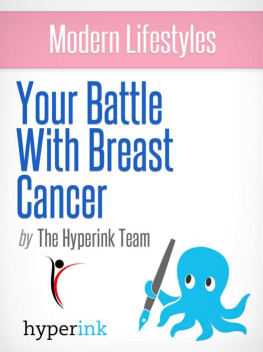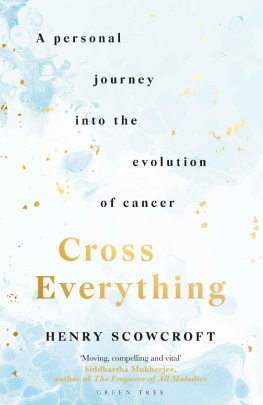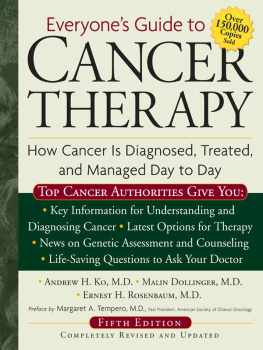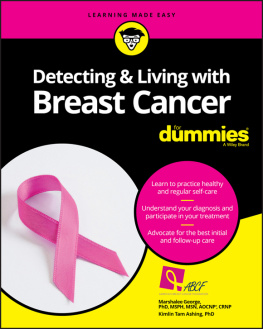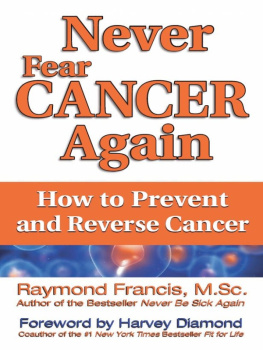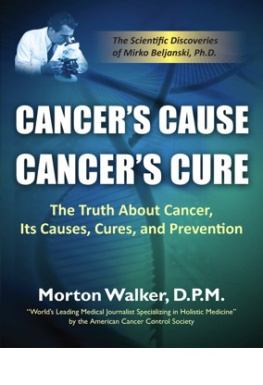
ONE IN THREE
ONE IN THREE
A SONS JOURNEY INTO
THE HISTORY AND SCIENCE
OF CANCER
ADAM WISHART

Copyright 2007 by Adam Wishart
All rights reserved. No part of this book may be reproduced in any form or by any electronic or mechanical means, or the facilitation thereof, including information storage and retrieval systems, without permission in writing from the publisher, except by a reviewer, who may quote brief passages in a review. Any members of educational institutions wishing to photocopy part or all of the work for classroom use, or publishers who would like to obtain permission to include the work in an anthology, should send their inquiries to Grove/Atlantic, Inc., 841 Broadway, New York, NY 10003.
Extract from Miss Gee from Collected Poems by W. H. Auden (p. 68) printed here with the kind permission of Faber and Faber.
Extract from How to Behave with the Ill reproduced with the kind permission of Julia Darlings family. The poem is published in The Poetry Cure, edited by Julia Darling and Cynthia Fuller (Newcastle University/Bloodaxe Books, 2005).
FIRST EDITION
Library of Congress Cataloging-in-Publication Data
Wishart, Adam, 1968
One in three : a sons journey into the history and science of cancer
/Adam Wishart.
p. cm.
Includes bibliographical references and index.
eBook ISBN-13: 978-1-5558-4887-3
1. CancerHistory. 2. CancerPatientsBiography. 3. Fathers and sons. I. Title.
RC275.W57
362.1969940092dc22
[B] 2006050909
Grove Press
an imprint of Grove/Atlantic
841 Broadway
New York, NY 1003
Distributed by Publishers Group West
www.groveatlantic.com
For Dad
Content
Introduction
I cling to my dads enormous hand. With long strides, we are rushing through London. I am six. I am sometimes catching my step, sometimes just being lifted by his forward thrust. I am wearing a bright yellow cape, with a sailors hat to keep the rain off, and at every puddle I splash the rushing Christmas shoppers. Dad scolds me, but I know he doesnt mean it: we are a tight pair. We are coming from an exhibition about some ancient civilization at the Royal Academy, where he had lifted me high above the crowds so that I could see the twinkling gold swords. Now we have to get somewhere, probably the coffee-bean shop in Soho, for he has very particular tastes. Although we are in a hurry, as we round a corner he stops sharply and I charge straight into his camelhair coat. It is warm and wet. We have paused because he wants to tell me a story of a man called John Snow, whose name and picture is on a pub sign across the road.
Many years ago, Dad says, Dr. Snow had hundreds of patients dying of a particularly vicious disease. As Snow had no idea what caused it, he could neither treat nor prevent it. So to discover what connected the patients, he drew a map of London and placed dots where each one lived. Dad sweeps his hand down Broadwick Street, explaining the map: here was dark with dots, but farther away the dots became sparser. Dad asks me what linked them. I scratch my head. The doctor didnt know either. So he questioned the families about their lives. With a flourish, Dad points to the spot where a water pump once stood, and says that Snow realized that all the ill people had used this pump. Some liked the taste of its water so much that they had even traveled from afar. To stop the disease, Snow simply removed the handle of the pump. Nobody became ill again.
Dad tells me it was the first piece of work on demonology. I ask him what kind of demons, but he only laughs.
It amused him that I had misheard the word epidemiology, the science of epidemics, especially since this was a subject he taught to his statistics students.
Being taught about the cholera epidemic of 1854 is my first memory of Dads quest to educate meeven though in hindsight Dads story was a rather mythologized and child-friendly version of history. From then on, he was always telling me stories about scientists, mathematicians, and revolutionaries, from Marie Curie to Benjamin Franklin. From my adolescence it was our habit to stay up late and, with Mum in bed, to sit talking about these things at the kitchen table. For two men who never spoke about their feelings, our intimacy consisted in sharing our interests in politics, history, or the progress of science. If I knew history, he thought, then I might be better able to navigate through my life, because he had always used the past as a way to understand his place in the world.
For as long as I can remember, I was the one who would eventually leave the table. Dad would lock the doors and begin to turn off the lights. I would make my way to bed. The final part of the ritual was that he would open my door just enough for him to stick his head through and wish me good night. Then I would listen as he darkened the house before turning in.
Many years later, when Dad became ill, we began spending more time together again and we continued to tell those stories, although this time they would be about the scientists, doctors, and patients who had struggled against cancer across the centuries. I searched for a book that we could both read and then discuss. There were memoirs of celebrities who had battled through the disease, but I knew that Dad would have no interest in those. There were self-help guides that presented basic information but provided no wider context. There were books that described the science in detail, but they didnt seem to connect to the experience of being a patient. And there were academic histories, which didnt seem to bring the past alive.
Even without a book to fall back on, Dad pondered the big questions. Why was there no cure yet, for instance? And I would search libraries for biographies of those who had tried and the reasons why they had failed. Dad would show me a newspaper cutting about the latest genetic cancer cures, and I would try to paint in the background with my recently acquired knowledge. It was like some game from my childhood, but with dark undertones, because the purpose was to provide a distraction from the blizzard of pain.
This book is, in part, the culmination of that journey. It tells the history of cancer medicine, from the Victorian surgical solution to the latest developments in gene therapy, through a dozen stories of scientific endeavor. These are stories of maverick doctors searching for a cure although their colleagues thought them charlatans and of patients campaigning to stay alive. Running through them is a vein of the wider history of medicine and of the development of sciences understanding of human biology. At the same time, these stories address some of the basic questions that Dad and I had about cancer: what is the biology of the disease, how does a tumor grow, why is it so difficult to detect sometimes, and how does radiation or chemotherapy work?
Dads illness mirrored these historical moments. At times, medicines history had direct relevance to his own experience. At others, the spirit of some historical age seemed to resonate with the mood of the family. As a consequence, the story of Dads illness forms a counterpoint to the broader history of humanitys struggle against cancer.
It is almost four years since that moment when I was told that Dad was ill and I became filled with fear. I wish that I had known then what I know now, because learning something about cancer calmed some of those terrors.
Next page

